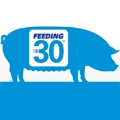 Economics on sow operations are driven by feed efficiency – especially during times of high-priced inputs. As input costs continue to rise, small changes in ration formulations and management can have financial impacts. Sow feed efficiency – and the economic potential of operations – can be enhanced by paying attention to feed particle size, ration waste and herd replacement rates.
Economics on sow operations are driven by feed efficiency – especially during times of high-priced inputs. As input costs continue to rise, small changes in ration formulations and management can have financial impacts. Sow feed efficiency – and the economic potential of operations – can be enhanced by paying attention to feed particle size, ration waste and herd replacement rates.
Dan McManus, DVM, swine nutrition specialist for Land O’Lakes Purina Feed, LLC, says that to determine feed efficiency in the breed-to-wean stage, divide pounds of feed fed by the number of weaned pigs produced in the facility.

“Once producers know that number, they have a benchmark to work from,” he says. “Producers can then improve feed efficiency by either decreasing the amount of feed fed without decreasing their marketable output or improving weaned pig output with the same amount of feed.”
When working to meet feed efficiency goals, McManus evaluates particle size of the diet, ration waste and replacement rates.

Particle size
“Particle size of feeds in the diet plays a role in feed efficiency,” he says. “Like the finishing pig, reduced particle size allows the sow to utilize energy more efficiently in gestation and lactation.”
Researchers at Kansas State University found that reducing corn particle size from 1,200 to 600 microns can improve feed intake and weaning weights. Study authors conclude that the reduction in particle size improves nutrient digestibility because small particles have more surface area available for enzyme digestion in the intestinal tract of the pig.
Manage ration waste
Wasted feed directly impacts feed efficiency because it adds cost to pounds gained. “Avoid overfeeding of animals and watch for areas where feed is wasted in the gestation and farrowing barns,” McManus recommends.In warm months, ration waste can be reduced by adjusting the diet for decreased consumption. McManus states that summer ration changes may be needed to offset body weight losses in lactation that increase the wean-to-service interval. Nutrient-dense diets can provide higher nutrient levels to sows when warm temperatures may reduce consumption.
“Consider adopting feed technologies that help maintain consumption,” McManus says. “Feed additives can help sows to handle heat stress without losing consumption.”
Herd replacement rates
Focusing on overall sow herd health and longevity can help increase outputs without adding to the feed bill.
“Herds with a lower annual herd replacement rate have better feed efficiency because they need a smaller supply of replacement gilts in the pipeline,” McManus says. “Fewer gilts will result in a lower gilt developer feed bill.
“Managing particle size, ration waste and herd replacement rates can improve the feed efficiency of a herd over time,” McManus adds. “Improved feed efficiency will reduce feed costs per weaned pig and improve a producer’s bottom line.”

July 19, 2012 - Feeding for 30TM



